Liore-et-Olivier LeO 13
LeO 13 (H-13) представлял собой двухмоторную летающую лодку, первый полет которой состоялся в июле 1922 года. Самолет проектировался под требования французских авиакомпаний, обслуживавших маршруты в районе Средиземного моря. Впрочем, самолет был доработан для военных задач - он вооружался двумя 7,7-мм пулеметами Lewis и мог брать на борт до 25 кг бомб. H-13 состоял на вооружении военно-морской авиации Польши (два самолета H-13B-3 и два H-13E) и Франции. Но H-13 оказался достаточно капризной машиной, опасной более для пилота, чем для противника, так что вскоре французский флот переориентировал их на решение учебных задач.
Варианты
H-191 LeO H-13: опытный самолет
LeO H-13A: пассажирский вариант; построено 23 самолета
LeO H-13B-3: разведчик-бомбардировщик; построено 20 самолетов
LeO H-13E: учебно-тренировочный вариант; построено 10 самолетов
Показать полностьюShow all
Liore-et-Olivier H-13 и H-135
В начале своей деятельности компания "Liore-et-Olivier" изготовила множество опытных летательных аппаратов. В течение достаточно короткого периода времени появились: двухместный ночной истребитель-разведчик Liore-et-Olivier LeO 8 с крылом типа парасоль (в категории CAN.2); низкоплан LeO 9 - одноместный истребитель в категории C.1; двухпоплавковый разведывательный биплан LeO H-10.
LeO H-13, спроектированный Андриеу, был более удачен - опытный LeO H-13.01 поднялся в воздух в июле 1922 года. Это была равнокрылая летающая лодка - биплан с однореданным корпусом, которая оснащалась двумя V-образными восьмицилиндровыми двигателями Hispano-Suiza 8Aa мощностью по 150 л.с. В носовой части располагалась пассажирская кабина на четырех человек, а пилот находился в открытой кабине, размещенной сразу за крыльями. В общей сложности были построены 22 самолета H-13 и три LeO H-13A.
"Liore-et-Olivier" создала авиакомпанию "Societe Maritime de Transports Aeriens l'Aeronavale" в конце 1921 года, а на следующий год выставила на маршруте Антиб - Аяччо (Корсика) самолеты LeO H-13. Другая авиакомпания с мая 1923 года стала использовать два LeO H-13A на маршруте Марсель - Алжир. H-13 имел размах крыльев бипланной коробки 16,00 м, максимальную взлетную массу 2564 кг и максимальную скорость 160 км/ч.
Другие пассажирские варианты: H-13bis, разработанный изначально для ВМС как разведывательная летающая лодка с двумя двигателями Hispano-Suiza 8Ab мощностью по 180 л. с. (построен один самолет); H-132 (построены два самолета); H-133 с одним мотором Renault 12Fe мощностью 300 л. с. и толкающим винтом (построены четыре самолета); H-134 - совместил в себе корпус от H-13bis и бипланную коробку от H-13, оснащался одним двигателем Lorraine 12Eb мощностью 450 л. с. (два самолета переоборудованы из H-13).
Две военные модификации H-13 отличались пилотской кабиной, перемещенной вперед, перед крыльями, а также установленными носовой и надфюзеляжной стрелковыми точками с пулеметами. Амфибия H-135 с экипажем из четырех человек оснащалась двумя двигателями Hispano-Suiza 8Ab по 180 л. с. Семь самолетов были поставлены в Польшу для военно-морской авиации, где использовались для учебной подготовки, патрулирования и др.
Опытный H-136 проходил испытания в Сен-Рафаэле, пилотская кабина у него располагалась позади крыльев - как и на ранних гражданских вариантах. 12 серийных летающих лодок H-136 были построены в 1927 году для ВМС Франции. Самолеты напоминали H-135, имели те же двигатели, но корпус их был несколько длиннее. Лодка H-136 имела размах крыльев 16,00 м, максимальную взлетную массу 2500 кг и максимальную скорость 145 км/ч. Самолет рассматривался как морской патрульный, его вооружение включало два 7,7-мм пулемета.
Показать полностьюShow all
Flight, January 1923
THE PARIS AERO SHOW 1922
LIORE AND OLIVIER, Levallois-Perret (Seine)
Two LeO machines were shown by this firm, one a twin float seaplane intended for naval reconnaissance work and the other a cabin flying boat commercial machine. Of the two the flying boat was the more interesting, as similar machines are in daily use between Antibes and Corsica, where they maintain a regular service.
The LeO H.13 is a twin-engined flying boat with two Hispano engines mounted on Vee struts high in the gap and close together, so that it should be possible to fly the machine straight, with but one engine running, or at any rate greatly to prolong the glide and thus be able to come down near a vessel or near the coast, according to circumstances. The machine really bears evidence of being a serious attempt at evolving a truly commercial flying boat, and although certain features may not agree with our ideas, the LeO 13 is entitled to careful consideration.
The boat hull is of the flat-sided variety, with three-ply wood planking. It is divided into 7 watertight compartments, and has but a single step, occurring slightly aft of the rear spar. The cabin has seating accommodation for four passengers, but if desired room can be provided for six or more. The cabin is entered through a hatch in the deck near the bows, and in the aft wall is a small door leading to a luggage compartment and to the pilot's cockpit, which is situated behind the wings. The cabin is lighted by windows in the side of the hull.
Aft of the lower plane the deck of the boat is raised into a flat sort of turret, and here is situated the seat for the pilot and navigator, or wireless operator. It seems probable that the view obtained is somewhat restricted by the fairly wide bows of the boat, and it might be expected that the slip stream from the tips of the two propellers would be somewhat inconvenient. We are informed, however, that pilots have expressed themselves satisfied both with the view and the general comfort, and certainly in case of a crash the pilot should stand a rather better chance than the passengers enclosed in the cabin.
The wings are of Gottingen No. 430 section, and, with the exception of the engine struts, there is but one pair of interplane struts on each side. In view of the deep spars which can be accommodated in the Gottingen section, this is probably sufficient.
The two 150 h.p. Hispano-Suiza engines are mounted high in the gap between the planes, and their bearers are supported on Vee struts in front and Y struts to the rear spars. A single Lamblin radiator is mounted in the angle between the legs of the Vee struts, below the engine. The petrol tank forms a very deep top centre-section, and owing to the height above the engines direct gravity feed can be employed, with consequent increase in reliability and reduction in piping and other weights.
The main characteristics of the LeO H. 13 are as follows: Length, o.a., 11-5 m. (37 ft. 7 ins.); span 16 m. (52 ft. 4 ins.); wing area, 58 sq. m. (623 sq. ft.); weight empty 1,600 kgs. (3,520 lbs.); fuel for 4 hours at full throttle 300 kgs. (660 lbs.); useful load, 550 kgs. (1,210 lbs.); total loaded weight, 2,450 kgs. (5,390 lbs.); wing loading, 42-2 kgs./sq. m. (8-6 lbs./sq. ft.; power loading, 8-2 kgs./h.p. (18 lbs./h.p.); speed at sea level, 160 km. (99 m.p.h.); radius of action about 350 miles.
A similar model, but with retractable undercarriage for amphibian use, is fitted with two 180 h.p. Hispano engines.
<...>
Показать полностьюShow all
Flight, August 1923
GOTHENBURG International Aero Exhibition 1923
The French Section
Etablissements Liore et Olivier, Levallms-Perrel, showed their twin-engined flying boat, type LeO. 13, which was exhibited at the last Paris Aero Show. Although thus this machine cannot lay claim to any novelty interest, it may justly be considered a thoroughly tried old friend, having been in constant use on the route Antibes-Ajaccio, as well as on the Barcelona-Palma-Algiers line. The machine has two Hispano-Suiza engines of 50 h.p. each, and carries six passengers in an enclosed cabin. The hull is of the flat-sided type, with a single step of small depth. The wing section used is one of the Gottingen series, and is fairly thick, giving good spar depth.
The main characteristics of the LeO.13 are: Length, o.a., 11-5 m. (35 ft.); span, 16 m. (52 ft. 6 ins.); wing area, 58 sq. m. (625 sq. ft.); weight empty, 1,600 kgs. (3,500 lbs.); weight of fuel for 3 1/2 hours' flight, 300 kgs. (660 lbs.); useful load, 600 kgs. (1,320 lbs.); total loaded weight, 2,500 kgs. (5,480 lbs.); wing loading, 8-8 lbs./sq. ft.; power loading, 18-25 lbs./h.p.; speed, about 160 km. (100 m.p.h.).
Показать полностьюShow all











